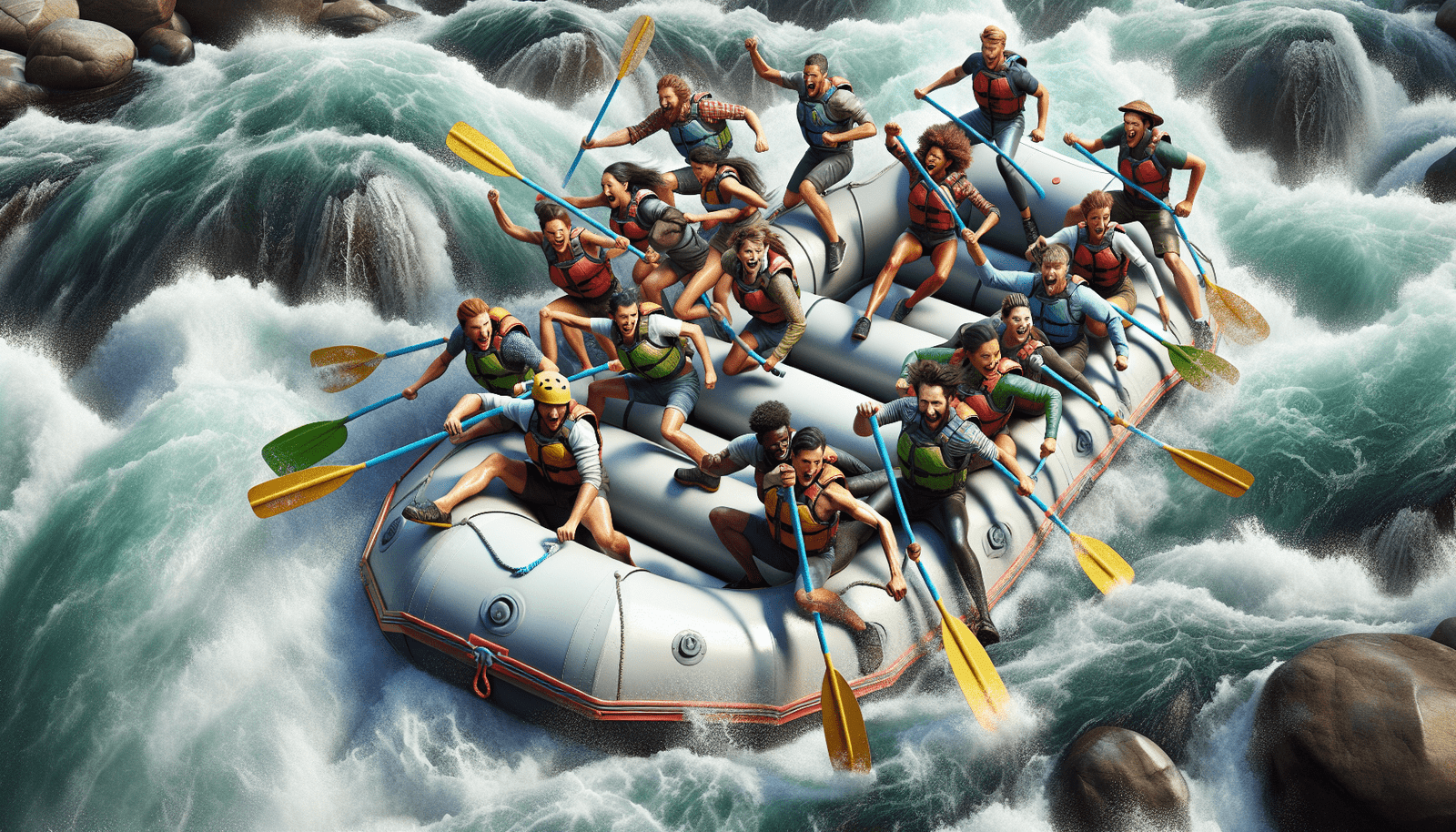River Rafting
Imagine the rush of icy water against your skin, the thrilling unpredictability of the rapids, and the sheer exhilaration as you navigate your raft through the heart of the untamed river. Yes, that’s exactly what the adrenaline-fueled adventure of river rafting feels like. Strapping on a life jacket, gripping onto your paddle, working in sync with your team to stay afloat – this article is all about the magnificent thrill and inherent challenges of river rafting.

Understanding River Rafting
The thrill of navigating through turbulent rivers, working in unison with others, and embracing the raw power of nature are all encapsulated in the exhilarating sport known as river rafting. It’s a water-based adventure that’s accessible to almost everyone, as long as you’re willing to get a little wet and wild.
What is River Rafting
River rafting is a recreational outdoor activity where you use an inflatable raft to navigate a river or other body of whitewater. It sounds simple enough, right? But it’s much more than just floating downstream. Rafting involves understanding water conditions, working with a team, and using specific techniques to steer the boat and stay safe. It can be both a leisurely ride in gentle waters, or an adrenaline-fuelled challenge in high-grade rapids.
History of River Rafting
Did you know river rafting began in the early 19th century? Originally, it was just a means of transportation, but soon became a beloved pastime across the world. John Wesley Powell, a one-armed Civil War veteran, is often credited as one of the pioneers of river rafting for recreational purposes when he navigated the Colorado River in 1869.
The Importance and Popularity of River Rafting
River rafting holds an important place in today’s culture of outdoor adventures. It’s a popular activity among thrill-seekers, outdoor enthusiasts, and family vacationers alike. It also fosters teamwork, making it an often-employed activity in corporate team-building exercises. Moreover, its popularity has generated a significant tourism industry, leading to the economic growth of many regions with suitable rapids.
Prerequisite Skills for River Rafting
While river rafting is an activity open to all, it does require some basic skills and preparation to ensure you have a safe and enjoyable experience.
Physical Fitness Requirements
You don’t have to be an Olympic athlete to participate in river rafting, but a certain level of physical fitness is required. Strength, endurance, flexibility, and balance will be put to the test as you hop into the raft and paddle against the powerful current.
Swimming Skills
While a good swimmer has an advantage, non-swimmers shouldn’t be discouraged from river rafting. A majority of the rafting companies require participants to wear life-jackets, ensuring floatation even in turbulent water. However, basic knowledge of staying calm, floating and treading water can surely be handy.
Basic Paddling Techniques
Effective paddling techniques are crucial to maneuver the raft. Most rafting companies provide a brief training before the ride, introducing the basic forward, backward and stop strokes.
Risk and Safety Management
River rafting comes with its inherent risks, and understanding how to manage these risks is crucial. This includes knowing the safety equipment, understanding the different classes of rapids, and being aware of the potential dangers in a rapid river such as boulders, fallen trees, and sudden drops.
Equipments Used
Proper equipment is key in ensuring a safe and enjoyable rafting experience. This includes the raft itself, as well as various pieces of safety and personal equipment.
Types of Rafts
There are several types of rafts available, each designed with specific rafting conditions in mind. From large, stable rafts for family-friendly class I rivers to smaller, more maneuverable rafts for challenging class V rivers, there’s a raft for every whitewater condition.
Safety Equipment
Every rafter should wear a life jacket or personal flotation device (PFD). A safety helmet is also required in most places, especially in high-grade rapids. Other safety equipment might include throw ropes, rescue bags, and first aid kits.
Rafting Gear
Your rafting gear would include paddle, waterproof bag for personal items, and – for multi-day trips – camping gear. Companies often provide most of this equipment.
What to Wear
Clothing for rafting should be comfortable, quick-drying and appropriate for the weather. Synthetic materials are often a good choice as they can keep you warm even when wet. In cooler weather, consider a wetsuit or drysuit. Always protect your feet with sturdy, close-toed shoes.

Basic Techniques in River Rafting
Once you’re geared up, it’s time to master the basics of rafting.
Paddling Cohesion
Working together is crucial to successful rafting. Everyone must paddle in coordination, led by the guide’s command, to effectively maneuver the raft.
Capsize Drills
Capsizes are part of the rafting experience. Learning how to safely exit a capsized raft and how to re-enter the raft from the water is fundamental.
Rescuing Techniques
Basic rescue techniques involve understanding how to use the safety rope, how to self-rescue by swimming to the raft or the riverbank, and how to assist in other’s rescue.
Command and Directions
Listening to and quickly following the guide’s commands are crucial to navigate rapids. These commands often involve paddling directions like forward, backward or stop.
Various Levels of River Rafting
River rafting is not a one-size-fits-all kind of sport – varying difficulties called “grades” cater to rafters of all skill levels.
Rating System
Rafting rivers are classified by six grades, from class I (easy with small waves) to class VI (extremely difficult, for experts only).
Basics of River Flows
Understanding river flows – how water moves through the river’s channels – plays a key role in navigating the raft. It influences where and how the raft moves.
Environment Factors Affecting River Rating
River grades can change due to several factors such as increased water flow due to heavy rains, temperature variations, or obstacles like fallen trees.
International Rafting Standards
To maintain safe and fair practices during river rafting, international standards and regulations have been established.
Standards Overview
These standards cover everything from safety equipment, raft specifications, course difficulty ratings, to guide certifications and training.
Rules and Regulations
Rules and regulations focus on safety. They include guidelines on what kind of equipment is mandatory, what procedures must be followed in emergency situations, and how privy rafting operators are to the local environment.
Certification Process
Those who wish to guide rafting trips or participate in professional competitions must pass certification processes established by authorised rafting organizations.
River Rafting Destinations Around the World
Thanks to the worldwide popularity of river rafting, you can find great rapids in every corner of the globe.
River Rafting in North America
From the rapids of Colorado River in USA to the mighty Fraser River in Canada, North America provides ample opportunities for rafting amidst stunning landscapes.
River Rafting in Europe
Europe offers diverse rafting experiences, from the glacier waters of Norway’s Sjoa River to the wild rapids of Tara River in the Balkans.
River Rafting in Asia
Asia’s rafting hotspots include the fearsome Bhote Koshi in Nepal, and the stunning Ayung River in Bali.
River Rafting in Africa
Experience the unparalleled thrill of rafting on the Zambezi River in Africa, right at the foot of Victoria Falls, one of the seven natural wonders of the world.
Prominent River Rafting Events
River rafting has transformed from a recreational activity into a competitive sport, with local, regional and global events held regularly.
Local River Rafting Competitions
Many rafting enthusiasts participate in local competitions, which often include various categories like a sprint, head-to-head, slalom, and downriver.
Regional River Rafting Championships
Regional championships are a step up from local competitions, where the best rafting teams in the region compete for the title.
World Rafting Championship
The World Rafting Championships is the pinnacle of competitive rafting, where teams from all over the world gather to paddle their way to victory.
Training and Education in River Rafting
Learning proper rafting techniques, safety protocols and rescue tactics is crucial to becoming a proficient rafter.
Basics of Rafting Courses
Basic rafting courses cover fundamentals like understanding river flows, paddling techniques, capsize drills, and basic rescue measures.
Advanced Rafting Techniques
For advanced rafters, specific techniques like swift water rescue, river navigation, complex paddling techniques, and leadership skills are taught.
Certification Programs
Certification programs are available for those who want to become professional rafting instructors or guides.
The Impact of River Rafting on Environment
The rafting industry, like every other tourism-based industry, has both positive and negative impacts on the environment.
Environmental Conservation
Responsible rafting companies engage in conservation efforts to protect the river ecosystem. They educate rafters about the importance of leaving no trace and respect local wildlife.
Effects of Rafting on Flora and Fauna
While rafting brings economic benefits, irresponsible practices can harm local flora and fauna. Noise, pollution, littering and frequent human intrusion can disturb wildlife and affect plant life in the area.
Responsible Rafting Practices
The best way to minimize environmental impact is by following responsible rafting practices. This includes sticking to established routes, minimizing noise, and following the principles of pack it in, pack it out.
River rafting is not only about the adrenaline rush but it’s also about respecting the natural landscapes we get to explore. By fostering responsible rafting practices and continuing conservation efforts, we can ensure the rivers remain thriving for future generations to experience.




